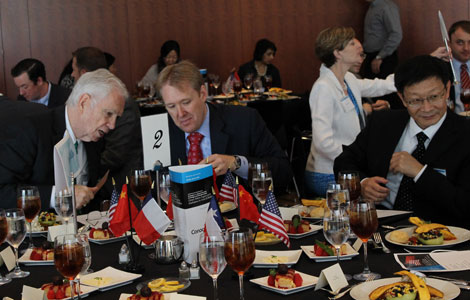Abe's cabinet endorses ambitious growth strategy
Updated: 2014-06-25 16:04
(Xinhua)
|
||||||||
 |
The ruling Liberal Democratic Party (LDP) threw its weight of support behind the economic reforms package, with Abe telling a news conference earlier Tuesday that the government's new growth strategy would steer the economy back to a sustainable recovery path.
"Whatever obstacles we have to overcome to tap into the potential Japan's economy has, we will deal with them. Implementing this growth strategy is the key to economic success," Abe said.
The long-awaited third arrow of the Abe's strategy for economic revitalization policies will see a government push for deregulation in the agricultural and medical sectors, as well as in areas concerning healthcare and employment -- long thought of as being sectors overly contributing to decades of deflationary pressure on the economy.
In addition, as widely expected, the expansive package also calls for a lowering of Japan's comparatively high corporate tax rate from 35 percent to below 30 percent, in a bid to attract more foreign direct investment, effective within a few years from fiscal 2015, and special economic zones with favorable tax incentives to be launched in autumn this year.
Reforms to Japan's labor force presented Tuesday, have been designed to allow for more flexible working schedules, attract more women to the workplace and increase the ratio of male-to- female executives, as well as allowing more foreigners to work in domestic and healthcare facilities, to further encourage more women to enter or return to the workforce, in a bid not just to increase corporate productivity, but also address the burning issues of Japan's shrinking and aging population.
The government also said it will provide more day care facilities for working mothers, as well as tax incentives to further encourage the augmentation of the female workforce, under a widely publicized reform policy dubbed "Womenomics."
A substantial increase in the government's budget has also been earmarked for the government's long-term goals to tackle the nation's slumping birthrate and maintain the nation's population level at around 100 million after 50 years.
The government's longer-term policy initiatives also outline details to revamp the healthcare sector, by offering patients more expansive and bespoke treatment options, catering to both insured and uninsured patents.
In Japan's highly protected agricultural sector, the government will, under its new provisos, seek to remodel the Central Union of Agricultural Cooperatives, known here as JA-Zenchu, which is an independent administrative body within the Japan Agriculture Group, which has traditionally outlined its own policy and administered the group.
The government has also committed to reform the Government Pension Investment Fund (GPIF), by shifting its priority away from buying domestic bonds and encouraging the purchasing of more risky assets, including Japanese stocks, in a bid to boost Japanese share prices by attracting more foreign buyers.
As the nation suffers under its burgeoning public debt at twice the size of its economy and the worst in the industrialized world, the government said it will, by fiscal 2020, turn its primary balance into surplus.
As Abe embarks on his second attempt to introduce his ambitious pillars of economic growth, with the government citing an uptick in domestic stocks following the provisional unveiling of the new growth strategy and longer-term policy blue print as a thumbs up to the wholesale economic revamp, in contrast with Abe's previous growth strategy unrolled in June last year, which failed to hit the mark and disappointed investors, some economists have said the monumental economic overhaul is still lacking in details.
Specifically, they have pointed to concerns over the generation of corporate tax revenues in light of the government's plans to lower levies, and strategies to parry the inevitable backlash from highly regulated sectors like farming, that the government is planning to liberalize.

 PLA ships arrive in Hawaii for world's largest naval exercise
PLA ships arrive in Hawaii for world's largest naval exercise
 NTSB blames Asiana crew for crash that killed three
NTSB blames Asiana crew for crash that killed three
 Xunlei goes public on the NASDAQ
Xunlei goes public on the NASDAQ
 Beijing, Boston are just 13 hours apart
Beijing, Boston are just 13 hours apart
 Stable reform expands US-China relations
Stable reform expands US-China relations
 Shanghai's Jews focus of DC show
Shanghai's Jews focus of DC show
 Fosun invests in studio to get Hollywood's know-how
Fosun invests in studio to get Hollywood's know-how
 Soldier's struggles inspire birth of an opera
Soldier's struggles inspire birth of an opera
Most Viewed
Editor's Picks

|

|

|

|

|

|
Today's Top News
China set to be net investor
Mediators can end labor wrangles, foreign firms told
Aquino backs Abe's military ambitions
Concern surrounds Chinese security forces in Iraq
Pilots' 'mismanagement' causes Asiana crash
Six Flags joins theme-park rush in China
Kerry in Iraq for talks with Kurdish leaders
All tsunami advisories canceled after Alaska quake
US Weekly

|

|







